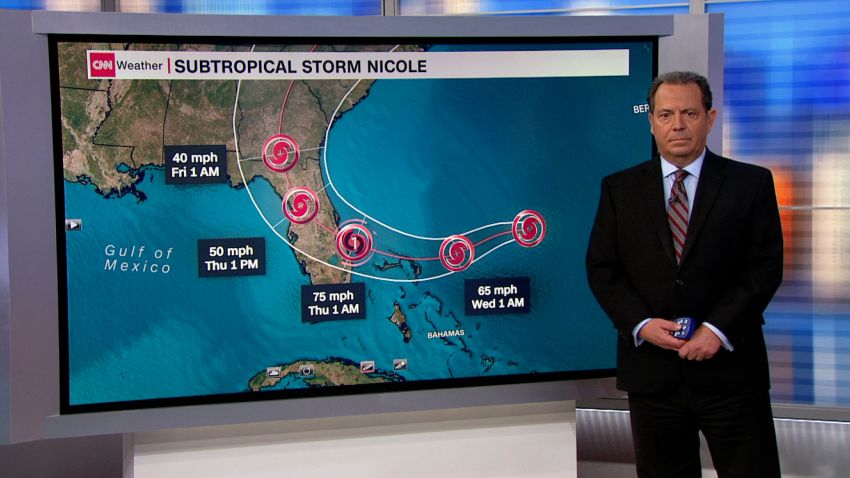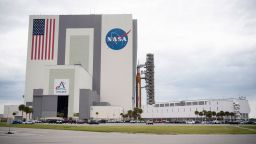Sign up for CNN’s Wonder Theory science newsletter. Explore the universe with news on fascinating discoveries, scientific advancements and more.
The Artemis I mission, which is expected to send an uncrewed spacecraft on a test mission around the moon, is delayed yet again, as NASA’s Space Launch System faces Tropical Storm Nicole, which is now expected to strengthen into a hurricane before it slams into Florida’s East Coast.
The space agency had been targeting November 14 for the third launch attempt but is now looking at November 16, “pending safe conditions for employees to return to work, as well as inspections after the storm has passed,” NASA said in a statement Tuesday evening. November 16 would offer a two-hour launch window that opens at 1:04 a.m. ET.
The rocket, often referred to as SLS, is sitting on its launchpad at Kennedy Space Center, which lies just to the north of where the storm’s center is expected to make landfall, CNN meteorologist Brandon Miller noted. That will mean the area can expect some of the strongest winds the system will bring.
If it is a 75-mile-per-hour (120-kph) Category 1 hurricane, as it’s predicted to be, gusts could range between 80 and 90 miles per hour (130 to 145 kph), according to Miller. That could mean the rocket will get battered by winds higher than the predetermined limits of what the rocket can withstand. Officials have said that SLS is designed to withstand gusts of up to 85 miles per hour (137 kph).
“Further, the National Weather Service in Melbourne, Florida, has forecasted max wind gusts occurring early Thursday morning of 86 miles per hour,” Miller added. “So yes, this is absolutely possible that wind gusts exceed that threshold.”
The National Hurricane Center’s latest report also gives a 15% chance that Cocoa Beach, which lies about 20 miles (32 kilometers) south of the launch site, will endure sustained hurricane-force winds.
Officials at NASA, however, said in a statement “forecasts predict the greatest risks at the pad are high winds that are not expected to exceed the SLS design.”
“The rocket is designed to withstand heavy rains at the launch pad and the spacecraft hatches have been secured to prevent water intrusion,” the statement continues.
Read more: The numbers that make the Artemis I mission a monumental feat
The space agency decided to roll the SLS rocket out to its launchpad last week, as the storm was still an unnamed system brewing off the East Coast. At the time, officials had been expecting this storm to bring in sustained winds of around 25 knots (29 miles per hour) with gusts of up to 40 knots (46 miles per hour), which was deemed to be well within the predetermined limits of what the rocket can withstand, according to comments from Mark Burger, a launch weather officer with the US Space Force’s 45th Weather Squadron, at a NASA news conference on November 3.
“The National Hurricane Center just has a 30% chance of it becoming a named storm,” Burger said last Thursday. “However, that being said, the models are very consistent on developing some sort of a low pressure.”

But the storm did grow into a named system on Monday, three days after the rocket was rolled out to the launchpad.
The storm’s strength is unusual, as Nicole is expected to be the first hurricane to strike the United States in November in nearly 40 years.
To prepare for the storm, NASA said its teams have powered down the Orion spacecraft, which sits atop the SLS rocket, as well as the rocket’s side boosters and other components.
“Engineers have also installed a hard cover over the launch abort system window, retracted and secured the crew access arm on the mobile launcher and configured the settings for the environmental control system on the spacecraft and rocket elements,” according to the statement. “Teams also are securing nearby hardware and performing walkdowns for potential debris in the area.”
Kennedy Space Center announced on its Twitter feed Tuesday that it is “in a HURICON III status and continues to prep for the upcoming storm taking prudent precautions across all of our programs, activities, and workforce in advance of the storm.”
The HURICON III preparations include “securing facilities, property and equipment” as well as deploying a rideout team, which is a staff that will be on site to assess any damages.
The SLS rocket had been stowed away for weeks after issues with fuel leaks thwarted the first two launch attempts and then Hurricane Ian rolled through Florida, forcing the rocket to vacate the launchpad in September.
Officials at NASA returned the rocket to the launchpad last week with the goal of working toward a third launch attempt on November 14. It’s not clear how or if the storm could impact those plans.
The overall goal of NASA’s Artemis program is to return humans to the moon for the first time in half a century. And the Artemis I mission — expected to be the first of many — will lay the groundwork, testing the rocket and spacecraft and all their subsystems to ensure they are safe enough for astronauts to fly to the moon and back.
CNN’s Taylor Ward and Ashley Strickland contributed to this report.




